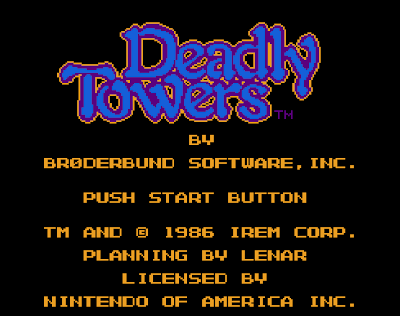From The CRPG Addict
 |
| In a typical Deadly Towers screen, I shoot swords at a variety of creatures with different movement paths. |
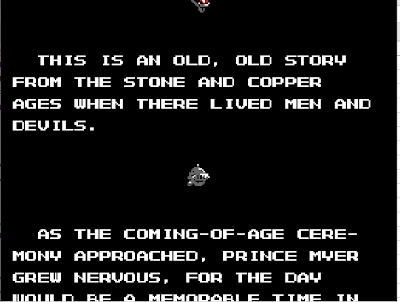 |
| And the “hyper” age, as we’ll soon see. |
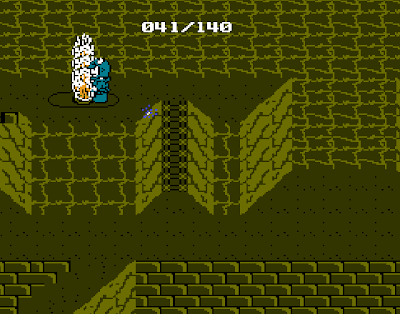 |
| Destroying one of the bells. |
(This is the kind of game that you must see in action to truly understand it. I recommend this review by YouTuber Cornshaq. He manages to cover it, including the ending, in 15 minutes. Notice the annoying music, which I turned off immediately, which starts over every time you enter a new area, so you’re always hearing the beginning of the same tune.)
The game is enormous and the map is essentially indecipherable. In basic structure, it consists of a castle of 10 outdoor levels, each level having access to one or more interior area. At the top of the castle are seven separate entrances to the seven towers. Each tower has about seven outdoor levels followed by another seven indoor levels. Any given doorway might turn out to offer a one-way trip to a completely different area, plus there are invisible teleporters to a “parallel world” or to various “secret areas.” Some of the secret areas have their own secret areas.
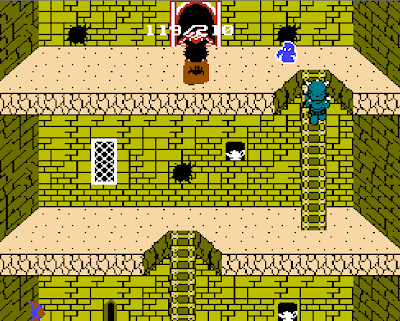 |
| Climbing to the top of one of the towers. Any random set of pixels on one of these levels could be a teleporter to a secret area. |
Every one of the screens is full of blobs, worms, bats, spiders, ghosts, imps, demons, fuzzes, whobs, and whazzits trying to kill you. Some bounce up and down. Some fly back and forth. Some circle around. Some seem to attack you directly; others just move around randomly and hit you by chance. Some tear through the screen like a rocket. A few enemies fire projectiles. You must avoid or kill these creatures–which respawn every time you leave an area and return.
Your weapons are a succession of swords, which somehow act as inexhaustible missile weapons rather than melee weapons, in that curious Japanese way that we also see in Ghosts ‘n Goblins (1985) and the Dragon Slayer series. Your starting sword, the short sword, requires about a dozen hits to kill even the most pathetic creature. The manual sympathizes, saying of the sword, “It is so weak, you feel lonely (you have no confidence in this sword).”
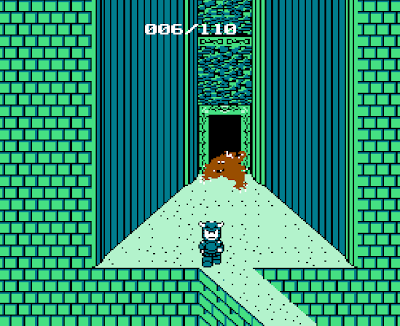 |
| My confidence fails. |
If you miss a creature with the sword, you have to wait until it goes sailing off the screen to fire another one. But if you hit, the creature is paralyzed for a couple seconds, which is usually enough to keep pelting it with swords until it dies. At the very beginning of the game, you’re extremely weak defensively as well, and just a couple of hits from the basest foes can kill you.
The money, you can spend in a variety of shops in the lower parts of the castle. The shops appear as pentagrams on the floors of certain rooms; stepping on them brings you down a ladder to an area where a shopkeeper offers up to three items. These include helmets, shields, gauntlets, better swords, and armor–although the best of each of these items are found in secret rooms in the towers.
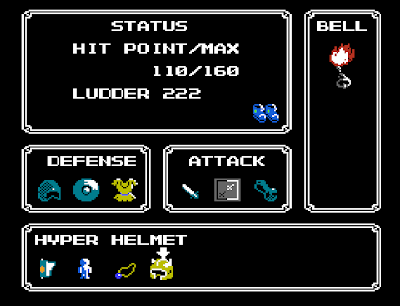 |
| My equipment about halfway through the game. I’ve destroyed one bell and have one to destroy. |
The castle shops also sell a variety of crystals, scrolls, potions, and other magic items that do things like heal you, teleport you to fixed parts of the game, weaken enemies, or improve your defenses for a short period. Items are relatively expensive while cash is slow to accumulate and (annoyingly) caps at 250.
 |
| Spending ludder in a store. |
When you reach the base of the seven towers, you find the holy flame. Each of the seven towers has at the top a boss creature who fires copious missiles. You can defeat almost all of them by retreating to a corner, shooting diagonally at the creature, and gulping a potion if you get too low on health. After the boss creature is dead, you collect the bell it was guarding, climb all the way back down the 14 or so levels, and toss the bell in the holy flame. Orange scrolls take you directly to the flame, and I learned to prize these items above all others.
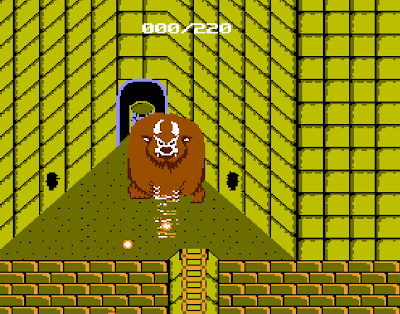 |
| The “Death Bear,” one of the seven tower bosses, kills me. |
 |
| I’m doing better against this other boss, “Wheeler.” |
All of this makes Towers sound like a perfectly acceptable action game, but there are a number of factors that unbalance it. First, it has no real save capability. When you die, you get an alphanumeric code that you can enter at the beginning of the next game. The code retains your hit points, most of your equipped items, and the bells you’ve destroyed, but none of the miscellaneous items in your inventory like potions and scrolls. The only way to save and continue later is to deliberately die and suffer this pseudo-reload.
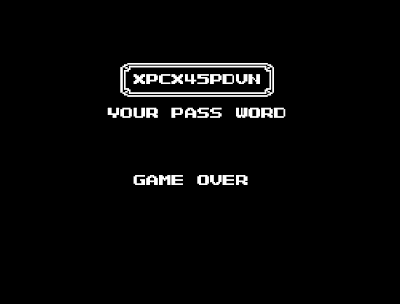 |
| A long password–which you have a limited time to write down. |
Second, many of the monster areas are insanely difficult. A lot of the teleporters drop you in the middle of, say, a swarm of bats. Even a quick player would have difficulty killing all of them before dying himself, though of course potions can make things easier.
 |
| I arrive in this secret area in the middle of a bat swarm. |
Third, the game is enormous, and if you’re playing blind, you don’t realize that about half of it is completely unnecessary. You really only want to explore the underside of the castle long enough to find the shops–a handful of rooms out of hundreds.
Fourth, the positioning of teleporters is spectacularly annoying. When you’re trying to reach some objective, they’re always there, invisible, waiting to derail you for an hour. When you’re trying to assemble a full set of equipment, they’re nowhere to be found. I finished the game without ever finding the “Dragonslayer” sword or a permanent weapon power-up that lets you shoot two parallel swords.
If you can deal with all of this and destroy the seven bells, then you have to return to the beginning of the game to gain access to the final area, where you find the best sword in the game, “Splendor.” You then engage in battle with two sub-bosses before meeting Rubas himself. I had saved a magic blue necklace, which renders you temporarily invincible, for this final battle, but it seemed rather quick and easy anyway.
 |
| Killing Rubas in the final combat. |
When the battle is over, the game spends a few minutes raining bells on you and then launches into a long bit of endgame text:
The hard and bitter battle has finally reached its end. Staring tiredly at Rubas’s destroyed castle, Prince Myer felt that his victory had fulfilled the promise of peace over the kingdom. His heart suddenly filled with a wondrous feeling. Looking up toward heaven, he heard a voice from far above, the same one that he had heard earlier by the lake. “My name is Khan. Prince Myer, you have done a great deed in defeating the Devil of Darkness. This brings an end to the Age of Stone and Copper. Peace will prosper in the kingdom.”
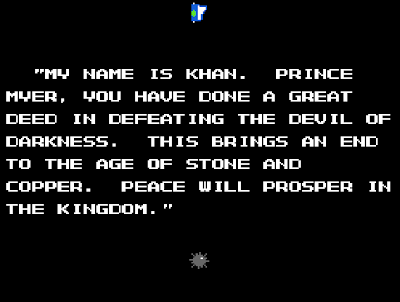 |
| Khaaaaaaaaaaan! |
At once, the prince returned to give the message of the victory to the king. The following day, he succeeded to the throne, being praised as the King of Light by the people. The peace and prosperity of the kingdom continued for about 1,000 years until the coming of the Iron Age, and the revival of the Devil of Darkness.
This is accompanied by a cute animation of the prince standing next to his father. Cue end credits.
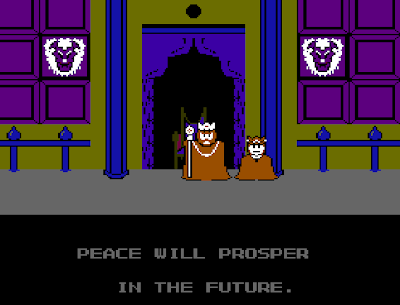 |
| Why is peace not prospering right now? |
Three hours would be a generous amount of time for a player using an invincibility cheat. It takes quite a bit longer if you don’t realize that you don’t have to explore every room in the castle. It takes even longer if you play with the intended difficulty and suck up every death. Naturally, save states ameliorate some of this difficulty. I tried to play “honestly” for a while, but some of the rooms were just blatantly unfair.
There are too many areas where, for no fault of your own, you simply die by entering a new area, and because many areas are invisible, you don’t have too much say in the matter. Walking past bottomless pits is stressful due to enemies materializing beneath you without warning, and with the password system not saving most of your items, you are set back farther than seems appropriate with every one of these very-regular deaths.
MobyGames’s summary of critic reviews offers ratings of 0, 10, 30, 40, and 50. A representative quote comes from the middle one:
Deadly Towers fails on every conceivable level. Even with a full walkthrough and maps it will be one of the most frustrating gaming experiences of your life. There really is no reason anyone should ever bother with this unless they have a hole in their head. This truly is one of the worst games ever made.
I can hardly argue. My GIMLET, with mostly 2s across the board, gives it a score of 15–the same rating that I gave Bokosuka Wars, although for very different reasons. I had a lot more fun with Bokosuka Wars even though I didn’t think it was much of an RPG.
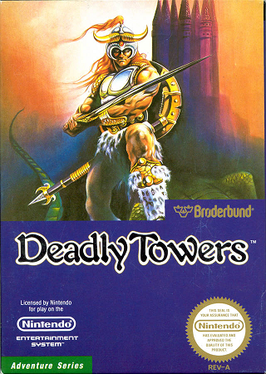 |
| Note that the figure on the cover looks nothing like the GCLM in the game itself. |
The Japanese title of the game was Mashou, which according to the Internet means “evil bell,” although every translator I feed it to gives “let’s go” instead. Lenar wanted to release the game as Hell’s Bells in the United States, but someone from Brøderbund suggested the final title. The game apparently sold quite well despite negative reviews. Lenar later developed two other RPGs–Knight Quest (1992) for the Game Boy and Magna Braban: Henreki no Yusha (1994) for the SNES. Developer Junichi Mizutari (AKA “J. Winc”) appears on the latter.
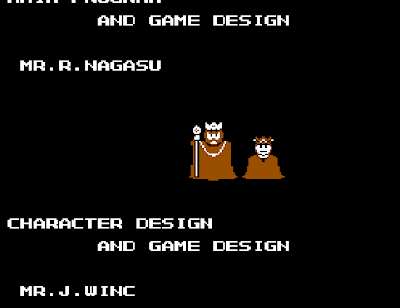 |
| I don’t believe Mr. R. Nagasu was ever seen again. |
I know some people thing there’s real RPG gold among these 1980 console titles, and I’m willing to keep holding out hope, but so far they’ve been toys. Toys can be fun, but there comes a time to put them away and do adult things. Like Challenge of the Five Realms.
Original URL: http://crpgaddict.blogspot.com/2019/11/game-346-deadly-towers-1986.html

